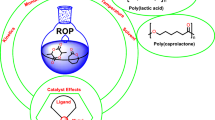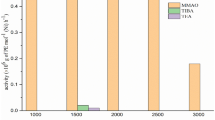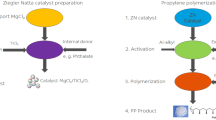Abstract
Exploring new polymerization strategy for current available monomers is a big challenge in polymer science. Here we re-investigate radical polymerization of monovinyl monomer (MVM) initiated by uniform branched polyfunctional initiator (PFI), which is termed non-linear radical additions-coupling polymerization (NLRAsCP). In NLRAsCP, both addition and coupling reactions of radical contribute to the construction of the polymer chains, which leads to continuous growth of branch topology. Theoretical analysis of NLRAsCP predicts that the gelation is determined by the functionality of PFI (a), the extent of initiation of the PFI (q) and the termination factor of radical (φ). NLRAsCPs of styrene and methyl methacrylate promoted by Cu(0)/Me6TREN or Mn2(CO)10/visible light were conducted. After the cleavage of incorporated PFI fragment or junctions in the network, the network was transformed to linear chains having almost the same structure as segmental chains in the precursor network. This allows the reverse deducing the network structure from its cleaved products. It has been proven that NLRAsCP includes stepwise initiation of PFI, chain-growth of segmental chains and successive endlinking of macroradicals derived from PFI. The three parameters related to the gelation process, a, q and φ, were adjusted via binary PFI, the feed ratio of [Mn2(CO)10]/[PFI] and addition of non-homopolymerizable comonomer respectively. The minimum values of a and q, and the minimum amount of comonomer required for gelation were determined, which can be applied to estimate φ of various macroradicals. NLRAsCP opens a general and facile strategy for synthesis of a variety of polymer networks with heritable architecture by one-pot polymerization of various MVMs.
Similar content being viewed by others
References
Cianga, I.; Yagci, Y. First polyrecombination reaction via atom transfer radical coupling (ATRC), a new way for the synthesis of poly(p-xylylene). Des. Monomers Polym. 2007, 10, 575–584.
Durmaz, Y. Y.; Aydogan, B.; Cianga, I.; Yagci, Y. The use of atom transfer radical coupling reactions for the synthesis of various macromolecular structures. Polym. Prepr. 2008, 49, 382–383.
Wang, C. H.; Song, Z. Y.; Deng, X. X.; Zhang, L. J.; Du, F. S.; Li, Z. C. Combination of ATRA and ATRC for the synthesis of periodic vinyl copolymers. Macromol. Rapid Commun. 2014, 35, 474–478.
Liu, Z.; Wang, Q. Radical coupling copolymerization (RCCP) for synthesis of various polymers. Polymer 2016, 100, 56–59.
Liu, Z.; Wang, Q. Radical coupling polymerization (RCP) for synthesis of various polymers. RSC Adv. 2016, 6, 39568–39572.
Li, C.; Wang, Q. Characterization of polymer network by combination of tailored synthesis and direct analysis of its decrosslinked components. Polymer 2016, 99, 594–597.
Zhang, C.; Wang, Q. Degradable multisegmented polymers synthesized by consecutive radical addition-coupling reaction of alpha, omega-macrobiradicals and nitroso compound. J. Polym. Sci., Part A: Polym. Chem. 2011, 49, 612–618.
Zhang, C.; Wang, Q. Step-growth radical addition-coupling polymerization (RACP) for synthesis of alternating copolymers. Macromol. Rapid Commun. 2011, 32, 1180–1184.
Zhang, C.; Ling, J.; Wang, Q. Radical addition-coupling polymerization (RACP) toward periodic copolymers. Macromolecules 2011, 44, 8739–8743.
Zhu, Q.; Wang, Q. Thermodegradable multisegmented polymer synthesized by consecutive radical addition-coupling reaction of α, ω)-macrobiradicals and dithioester. J. Polym. Sci., Part A: Polym. Chem. 2012, 50, 2029–2036.
Zhang, C.; Wang, Q. Block copolymers prepared by polymeric radical addition cross-coupling reaction to different double bonds. J. Polym. Sci., Part A: Polym. Chem. 2013, 51, 2817–2823.
Li, J.; Wang, Q. Radical addition-coupling polymerization with various nitroso compounds. J. Polym. Sci., Part A: Polym. Chem. 2014, 52, 810–815.
Tao, F.; Li, J.; Wang, Q. Aqueous radical addition-coupling polymerization for the synthesis of hydrophilic periodic polymer. RSC Adv. 2014, 4, 53253–53256.
Tao, F.; Wang, Q. Aqueous radical addition-coupling polymerization using a nitroso benzene/cyclodextrin complex for the synthesis of a hydrophilic periodic polymer. RSC Adv. 2015, 5, 46007–46010.
Liu, Z.; Wang, Q. Radical addition-coupling polymerization (RACP) of various benzyl-type biradical toward periodic polymers. Polymer 2016, 94, 14–18.
Liu, Y.; Fan, Z. Well-defined gels prepared by radical addition-coupling polymerization. Des. Monomers Polym. 2015, 18, 251–261.
Liu, Y.; Fan, Z. Novel hyperbranched polymers synthesized via A3+B(B’) approach by radical addition-coupling polymerization. J. Polym. Sci., Part A: Polym. Chem. 2015, 53, 904–913.
Bamford, C. H.; Dyson, R. W.; Eastmond, G. C. Studies in network formation. J. Polym. Sci., Part C: Polym. Symp. 1967, 16, 2425–2434.
Bamford, C. H.; Dyson, R. W.; Eastmond, G. C. Network formation IV. The nature of the termination reaction in free-radical polymerization. Polymer 1969, 10, 885–899.
Flory, P. J. Molecular size distribution in three dimensional polymers. III. Tetrafunctional branching units. J. Am. Chem. Soc. 1941, 63, 3096–3100.
Gao, H. F.; Tsarevsky, N. V.; Matyjaszewski, K. Synthesis of degradable miktoarm star copolymers via atom transfer radical polymerization. Macromolecules 2005, 38, 5995–6004.
Kannurpatti, A. R.; Anderson, K. J.; Anseth, J. W.; Bowman, C. N. Use of “living” radical polymerizations to study the structural evolution and properties of highly crosslinked polymer networks. J. Polym. Sci., Part B: Polym. Phys. 1997, 35, 2297–2307.
Yu, Q.; Zeng, F. Q.; Zhu, S. P. Atom transfer radical polymerization of poly(ethylene glycol) dimethacrylate. Macromolecules 2001, 34, 1612–1618.
Isaure, F.; Cormack, P. A. G.; Graham, S.; Sherrington, D. C.; Armes, S. P.; Butun, V. Synthesis of branched poly(methyl methacrylate)s via controlled/living polymerisations exploiting ethylene glycol dimethacrylate as branching agent. Chem. Commun. 2004, 1138–1139.
Hutchison, J. B.; Stark, P. F.; Hawker, C. J.; Anseth, K. S. Polymerizable living free radical initiators as a platform to synthesize functional networks. Chem. Mater. 2005, 17, 4789–4797.
Wang, A. R.; Zhu, S. P. Branching and gelation in atom transfer radical polymerization of methyl methacrylate and ethylene glycol dimethacrylate. Polym. Engin. Sci. 2005, 45, 720–727.
Wang, A. R.; Zhu, S. P. Control of the polymer molecular weight in atom transfer radical polymerization with branching/crosslinking. J. Polym. Sci., Part A: Polym. Chem. 2005, 43, 5710–5714.
Tsarevsky, N. V.; Matyjaszewski, K. Combining atom transfer radical polymerization and disulfide/thiol redox chemistry: a route to well-defined (bio)degradable polymeric materials. Macromolecules 2005, 38, 3087–3092.
Li, Y. T.; Armes, S. P. Synthesis and chemical degradation of branched vinyl polymers prepared via ATRP: use of a cleavable disulfide-based branching agent. Macromolecules 2005, 38, 8155–8162.
Bannister, I.; Billingham, N. C.; Armes, S. P.; Rannard, S. P.; Findlay, P. Development of branching in living radical copolymerization of vinyl and divinyl monomers. Macromolecules 2006, 39, 7483–7492.
Gao, H.; Min, K.; Matyjaszewski, K. Determination of gel point during atom transfer radical copolymerization with cross-linker. Macromolecules 2007, 40, 7763–7770.
Yu, Q.; Zhou, M.; Ding, Y.; Jiang, B.; Zhu, S. Development of networks in atom transfer radical polymerization of dimethacrylates. Polymer 2007, 48, 7058–7064.
Gao, H. F.; Li, W. W.; Matyjaszewski, K. Synthesis of polyacrylate networks by ATRP: parameters influencing experimental gel points. Macromolecules 2008, 41, 2335–2340.
Weiss, P.; Hild, G.; Herz, J.; Rempp, P. Preparation of crosslinked gels by anionic block-polymerization of styrene and divinylbenzene. Makromol. Chem. 1970, 135, 249–261.
Beinert, G.; Belkebirmrani, A.; Herz, J.; Hild, G.; Rempp, P. New crosslinking processes. Faraday Discuss. Chem. Soc. 1974, 57, 27–34.
Herz, J.; Rempp, P.; Borchard, W. Model Networks. Adv. Polym. Sci. 1978, 26, 105–135.
Hild, G. Model networks based on ‘endlinking’ processes: Synthesis, structure and properties. Prog. Polym. Sci. 1998, 23, 1019–1149.
Narita, M.; Nomurat, R.; Tomita, I.; Endo, T. Living polymerization of methyl methacrylate by novel samarium-based trifunctional initiator. Polym. Bull. 2000, 45, 231–236.
Matyjaszewski, K.; Miller, P. J.; Pyun, J.; Kickelbick, G.; Diamanti, S. Synthesis and characterization of star polymers with varying arm number, length, and composition from organic and hybrid inorganic/organic multifunctional initiators. Macromolecules 1999, 32, 6526–6535.
Stenzel-Rosenbaum, M. H.; Davis, T. P.; Chen, V. K.; Fane, A. G. Synthesis of poly(styrene) star polymers grown from sucrose, glucose, and cyclodextrin cores via living radical polymerization mediated by a half-metallocene iron carbonyl complex. Macromolecules 2001, 34, 5433–5438.
Durand, D.; Bruneau, C. M. General expressions of average molecular-weights in condensation polymerization of polyfunctional monomers. Br. Polym. J. 1979, 11, 194–198.
Durand, D.; Bruneau, C. M. Statistics of random macromolecular networks. 1. Stepwise polymerization of polyfunctional monomers bearing identical reactive groups. Makromol. Chem. 1982, 183, 1007–1020.
Zammit, M. D.; Davis, T. P.; Haddleton, D. M.; Suddaby, K. G. Evaluation of the mode of termination for a thermally initiated free-radical polymerization via matrix-assisted laser desorption ionization time-of-flight mass spectrometry. Macromolecules 1997, 30, 1915–1920.
Moad, G.; Solomon, D. H. 5 — Termination. In The chemistry of radical polymerization (Second Edition), Moad, G.; Solomon, D. H., Eds. Elsevier Science Ltd: Amsterdam, 2005; pp. 233–278.
Feng, X. S.; Pan, C. Y. Synthesis and characterization of star polymers initiated by hexafunctional discotic initiator through atom transfer radical polymerization. J. Polym. Sci., Part A: Polym. Chem. 2001, 39, 2233–2243.
Moschogianni, P.; Pispas, S.; Hadjichristidis, N. Multifunctional ATRP initiators: Synthesis of four-arm star homopolymers of methyl methacrylate and graft copolymers of polystyrene and poly(t-butyl methacrylate). J. Polym. Sci., Part A: Polym. Chem. 2001, 39, 650–655.
Francis, R.; Lepoittevin, B.; Taton, D.; Gnanou, Y. Toward an easy access to asymmetric stars and miktoarm stars by atom transfer radical polymerization. Macromolecules 2002, 35, 9001–9008.
Carlmark, A.; Vestberg, R.; Jonsson, E. M. Atom transfer radical polymerization of methyl acrylate from a multifunctional initiator at ambient temperature. Polymer 2002, 43, 4237–4242.
Strandman, S.; Luostarinen, M.; Niemela, K.; Tenhu, H.; Rissanen, K. Resorcinarene-based ATRP initiators for star polymers. J. Polym. Sci., Part A: Polym. Chem. 2004, 42, 4189–4201.
Huang, C. F.; Lee, H. F.; Kuo, S. W.; Xu, H. Y.; Chang, F. C. Star polymers via atom transfer radical polymerization from adamantane-based cores. Polymer 2004, 45, 2261–2269.
Lepoittevin, B.; Matmour, R.; Francis, R.; Taton, D.; Gnanou, Y. Synthesis of dendrimer-like polystyrene by atom transfer radical polymerization and investigation of their viscosity behavior. Macromolecules 2005, 38, 3120–3128.
Jankova, K.; Bednarek, M.; Hvilsted, S. Star polymers by ATRP of styrene and acrylates employing multifunctional initiators. J. Polym. Sci., Part A: Polym. Chem. 2005, 43, 3748–3759.
Kimani, S. M.; Moratti, S. C. Synthesis of five-arm star polymers with an inositol core by atom transfer radical polymerisation at ambient temperature. Macromol. Rapid Commun. 2006, 27, 1887–1893.
Buss, B. L.; Beck, L. R.; Miyake, G. M. Synthesis of star polymers using organocatalyzed atom transfer radical polymerization through a core-first approach. Polym. Chem. 2018, 9, 1658–1665.
Jochi, Y.; Seki, T.; Soejima, T.; Satoh, K.; Kamigaito, M.; Takeoka, Y. Spontaneous synthesis of a homogeneous thermoresponsive polymer network composed of polymers with a narrow molecular weight distribution. Npg Asia Mater. 2018, 10, 840–848.
Gilbert, B. C.; Harrison, R. J.; Lindsay, C. I.; McGrail, P. T.; Parsons, A. F.; Southward, R.; Irvine, D. J. Polymerization of methyl methacrylate using dimanganese decacarbonyl in the presence of organohalides. Macromolecules 2003, 36, 9020–9023.
Haines, L. I. B.; PoË, A. J. Initiation of vinyl polymerization by manganese carbonyl and carbon tetrachloride. Nature 1967, 215, 699–701.
Schreck, V. A.; Serelis, A. K.; Solomon, D. H. Self-reactions of 1,3-diphenylpropyl and 1,3,5-triphenylpentyl radicals: models for termination in styrene polymerization. Aust. J. Chem. 1989, 42, 375–393.
Bizilj, S.; Kelly, D. P.; Serelis, A. K.; Solomon, D. H.; White, K. E. The self-reactions of 1-methoxycarbonyl-1-methylethyl and higher ester radicals: combination vs disproportionation and oligomeric products from secondary reactions. Aust. J. Chem. 1985, 38, 1657–1673.
Gao, J.; Wang, Q. Polyacrylates networks synthesized by endlinking of 3-armed precursor via radical addition coupling reaction. RSC Adv. 2016, 6, 61615–61619.
Author information
Authors and Affiliations
Corresponding author
Additional information
Notes
The authors declare no competing financial interest.
Electronic supplementary material
10118_2022_2788_MOESM1_ESM.pdf
Non-linear Radical Additions-Coupling Polymerization of Monovinyl Monomers towards Polymer Networks: Theory, Tunability and Heritable Architecture
Rights and permissions
About this article
Cite this article
Ren, LM., Li, CL. & Wang, Q. Non-linear Radical Additions-Coupling Polymerization of Monovinyl Monomers towards Polymer Networks: Theory, Tunability and Heritable Architecture. Chin J Polym Sci 40, 1623–1630 (2022). https://doi.org/10.1007/s10118-022-2788-z
Received:
Accepted:
Published:
Issue Date:
DOI: https://doi.org/10.1007/s10118-022-2788-z




